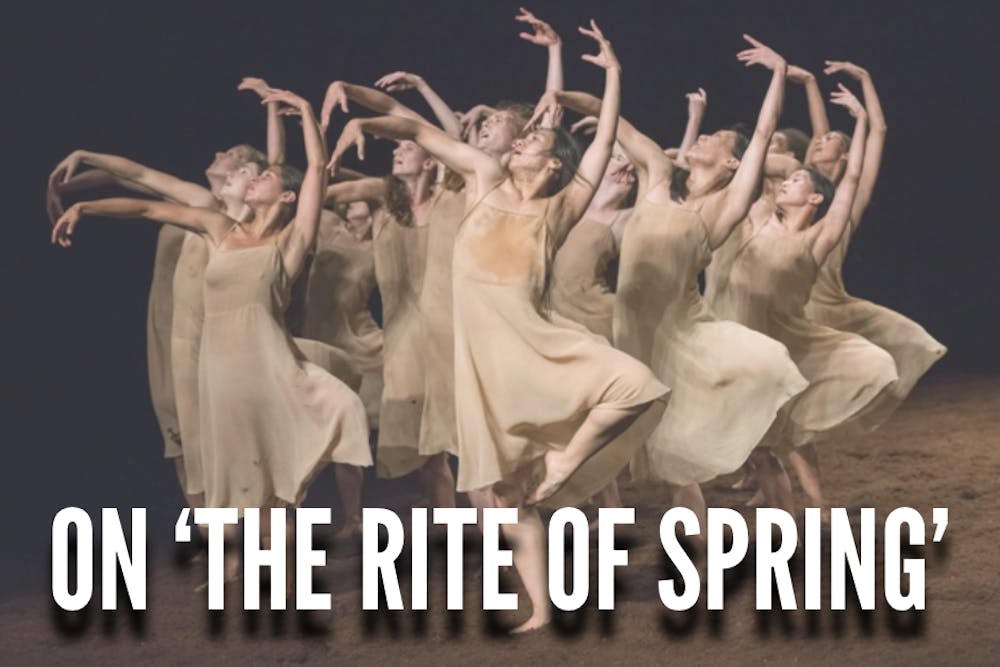The bassoon screams, the brass howls, the reeds yelp, the flutes titter, the strings thrash, the drums thump — little snatches of melody everywhere. A cacophony: it swells, it bursts and then it dies. For a moment, there’s something like folk music or bird song or plain chant; it dies too. This, over and over and over again.
Terrifying orchestral unisons emerge from the dissonance, whipping the music into a dance, seizing ballerinas like flotsam in the rapids of a river. The choreography is simple and infernal — great stomping circles and long leaping lines.
That’s “The Rite of Spring,” a ballet composed by Igor Stravinsky and choreographed by Vaslav Najinsky, which depicts a pagan tribe in ancient Russia celebrating a spring ceremony. It’s no Easter vigil, though: it ends with the sacrifice of a virgin, who — in the ballet’s grand finale — is forced to dance herself to death.
“The Rite of Spring” is on my mind for three reasons.
Firstly, because it always is. It's catchy and it’s a masterpiece — among the greatest achievements in twentieth-century orchestration.
Still, it’s a nightmare to play. In fact, the first recording to nail “The Rite” came from the conductor Pierre Boulez with the Cleveland Orchestra in 1969 — that is, 56 years after its debut in 1913. Before then, there were good recordings which achieved the right effect (e.g. the conductor Leonard Bernstein with the New York Philharmonic in 1958), but playing the piece precisely as written was considered impossible.
Secondly, because it’s spring. I like to match my music to the season and to the weather. When it’s rainy, for instance, I listen to jazz. Jazz can turn otherwise “depressing” weather into “atmospheric” weather (i.e. rain isn’t miserable, it’s moody).
“Spring” from Vivaldi’s “The Four Seasons” might match the spring weather in Georgia. Its baroque idiom is fresh and frilly. But in South Bend — where it snows in March, where it hails and swelters on the same day, where the wind whips across the parking lot at highway speed — that doesn’t cut it. You need something violent, something like “The Rite of Spring.”
Thirdly, because when I mention that I love classical music, people respond “I love classical music; it’s so calming!” or “I love classical music; it helps me study!” — and “The Rite of Spring” is the perfect rebuttal.
Saying “classical music is calming” is as absurd as saying “rap music is fun.” Lots of rap music is fun, of course, and lots of it is soul-crushing. So, too, with classical music. “The Rite of Spring” is classical music, but it's terrifying and invigorating — certainly not "calming."
To say “classical music helps me study” is to say “classical music is good background music,” and to say “classical music is good background music” is to say “classical music is good music to ignore.” That’s denigrating. “The Rite of Spring,” however, demands your attention by alternating between hypnotizing and shocking you. It’s impossible to ignore.
Nevertheless, I shouldn’t be too mean. The crowd who listen to classical music for relaxation and studying keep the lights on, keep the players fed. Plus, more often than not, the alternative to listening to a little classical music is listening to no classical music. Still, “The Rite of Spring” is a reminder that there are higher goods in classical music than being pretty and calming, than being merely listenable.
This spring, as birds begin to scream and coyotes begin to yelp and cicadas begin to titter again, turn on “The Rite.” You’ll find that stepping into its world — at once flamboyant and austere, dissonant and sonorous — isn’t too different from stepping outside.










